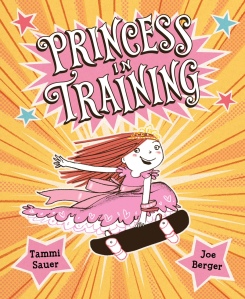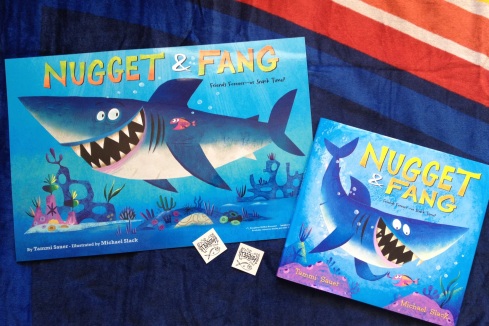You are currently browsing the tag archive for the ‘Princess in Training’ tag.
by Tammi Sauer (from 2012)
In past PiBoIdMo posts, I’ve encouraged you to…
This time around, I want to focus on structure.
Just like houses and dinosaurs, every story needs an underlying framework.


Most of my books follow the Classic Picture Book Structure:
- MC has a problem
- MC faces obstacles that escalate
- MC encounters a dark moment in which things can’t possibly get any worse
- MC figures out how to solve the problem
- MC grows/changes by the book’s end
My book PRINCESS IN TRAINING is an example of this.
Behold!
Princess Viola is great at skateboarding and karate-chopping, but she’s lousy at the royal wave, walk, and waltz. The king and queen are not pleased. What’s a princess to do? Attend the skill-polishing Camp Princess, of course. In the end, it’s a good thing Viola is made of tougher stuff. Who else will save the day when a hungry dragon shows up?
This is how the Classic Picture Book Structure works with PRINCESS IN TRAINING:
- Princess Viola Louise Hassenfeffer has a royal problem. She is not an ordinary princess and the kingdom is unhappy about it.
- Princess Viola faces three obstacles at Camp Princess (she is unable to properly master the royal wave, royal fashions, and royal dancing).
- A hungry dragon shows up at Camp Princess.
- Princess Viola uses her unique skill set to save the day.
- Princess Viola may not be an ordinary princess, but she is deemed the darling of her kingdom anyway.
Although the Classic Picture Book Structure is my super-favorite way to frame a story, there are a variety of other options. Below are many of them along with some examples.
Circular:
The story’s ending leads back to the beginning
If You Give a Mouse a Cookie; When a Dragon Moves In
Concept:
The story focuses on a single topic or category
All the World; Kindergarten Rocks; Hello Baby!; The Quiet Book
Cumulative:
Each time a new event occurs, the previous events in the story are repeated
My Little Sister Ate One Hare; I Know an Old Lady Who Swallowed a Fly
Mirror:
The second half of a story echoes what occurred in the first half of the story
Old Bear and His Cub; Boy + Bot; A Sick Day for Amos McGee
Parallel:
Two storylines are taking place at the same time
The Dog Who Belonged to No One; Meanwhile Back at the Ranch
Reversal:
Character and/or plot is portrayed in a way that is opposite from the norm
Bedtime for Mommy; Children Make Terrible Pets; Little Hoot
This month, I’m challenging myself to come up with at least one story idea for each of those frameworks. C’mon, groovy Storystorm people. Who’s with me?

Tammi Sauer has been a guest blogger for every year of Storystorm, even when it was called that thing no two people pronounced the same, PiBoIdMo. Learn more about Tammi at her super-snazzy new website tammisauer.com.

At the conclusion of Storystorm, prize packs will be given away (books, swag, writing tools). Comment once on this blog post to enter into the prize pack drawing.
You’re eligible to win if you’re a registered Storystorm participant and you have commented once below.
Good luck!
 by Tammi Sauer
by Tammi Sauer
For PiBoIdMo 2012, my blog post focused on a variety of ways a writer can structure a picture book.
This time around, I wanted to share a different approach to framing a story.
*drum roll, please*
THE HOW-TO… STRUCTURE
The How-To…Structure offers readers information on, you guessed it, how to do something.
Keep in mind, however, this structure isn’t just a list of bland, disjointed steps for accomplishing a task. Nope. Nope. Nope. These steps (along with the art) need to tell a real deal story. There should be a beginning, middle, and end. There should be characters, conflict, plot, setting…. There should be opportunities for your readers to feel something.
Some good examples of books that use the How-To… Structure are as follows:
Vampirina Ballerina by Anne Marie Pace, illustrated by LeUyen Pham
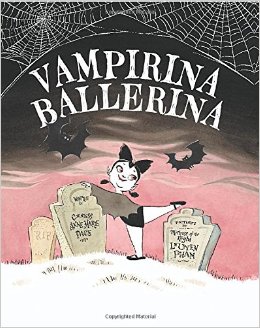
So You Want to Be a Rock Star by Audrey Vernick, illustrated by Kirstie Edmunds
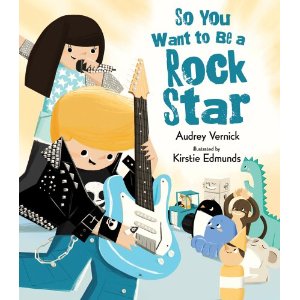
How to Babysit a Grandpa by Jean Reagan , illustrated by Lee Wildish
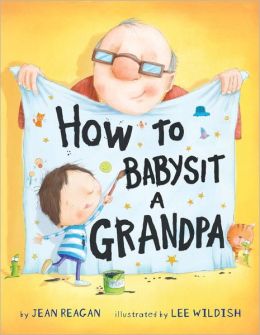
How to Wash a Woolly Mammoth by Michelle Robinison, illustrated by Kate Hindley
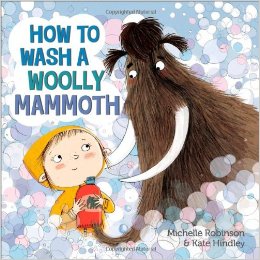
Your Challenge: Jot down a few possibilities for some How-To… books of your own. It might help to think in terms of a title. Even easier, just fill in the blanks to the prompts below and see where they take you.
How to__________
Guide to Being a ________
The __________ Handbook
This is what happened when I just filled in those blanks:
How to Catch a Dragon
Guide to Being a Big Brother
The Pirate’s Handbook
Extra Credit: Analyze the picture books I mentioned earlier in this post. How did those authors incorporate the How-To…Structure? Do you see some sort of story arc in these books? Did you notice any special word play? The rule of threes? What did you find particularly satisfying in those books?
Happy brainstorming, everybody!

Tammi Sauer is the author of Nugget & Fang, Princess in Training, and many other picture books. She has another eleven under contract. Her latest manuscript sold at auction. It followed the How to…Structure. Ooh.
You can visit Tammi at tammisauer.com and at picturebookbuilders.com.
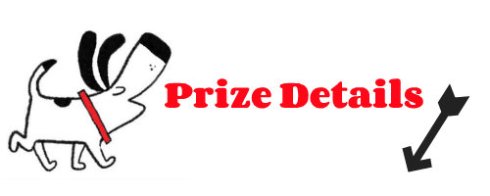

Tammi is giving away a signed copy of Nugget & Fang which won the 2014 Oklahoma Book Award, made the 2014 Texas 2X2 Reading List, and will be one of the featured books at the 2015 Scholastic Book Fair. Nugget & Fang was a PiBoIdMo 2009 Success Story.
Tammi will also give a picture book critique to another lucky duck winner.
These prizes will be given away at the conclusion of PiBoIdMo. You are eligible for these prizes if:
- You have registered for PiBoIdMo.
- You have commented ONCE ONLY on today’s post.
- You have completed the PiBoIdMo challenge. (You will have to sign the PiBoIdMo Pledge at the end of the event.)
Good luck, everyone!
 by Tammi Sauer
by Tammi Sauer
For me, the absolute hardest part about the picture book creating process is coming up with a good idea. A wow idea. An irresistible-to-editors idea.
One approach that has worked for me is to brainstorm a list of potential titles before I even know a single word of a manuscript. I keep in mind that I don’t want a book of mine to have just any title. I always try to have a title that pops. Why? The title is a writer’s first chance to make a good impression and hook a possible agent/editor/reader.
Two of my books started with a title.
One day, while waiting for my daughter to find a book at the library, I sat down on a bench. Next to me was a book on etiquette. I flipped through the book and came across the words “princess in training.” My first thought? That would make a great idea for a picture book….and…
…In fall 2012, PRINCESS IN TRAINING, illustrated by Joe Berger, made its debut.
Another day, I was playing around with words that rhymed with names. As I brainstormed, the words “Quiet Wyatt” popped into my head. QUIET WYATT recently sold to Houghton Mifflin Harcourt BFYR.
My latest manuscript is the result of a title that grabbed hold and said, “You must drop everything and write this.” So I did. A good title can be very pushy. And intoxicating.
If you want to come up with a title as a starting point, consider using these strategies:
- Showcase a Main Character
examples: Vampirina Ballerina; Fancy Nancy; Scaredy Squirrel
- Focus on the Setting
examples: Cowboy Camp; In the Small, Small Pond; The Library
- Create a Sense of Suspense
examples: The Monster at the End of This Book; Do Not Open This Book
- Utilize Fun Language Play
examples: Chicks and Salsa; Hush, Little Dragon; Llama, Llama Misses Mama
Side Note: I happen to be wildly jealous of the upcoming books There Was an Old Dragon by Penny Klostermann and Tyrannosaurus Wrecks by Sudipta Bardhan-Quallen simply because I am gah-gah over those titles. Why didn’t I think of those titles?! Why?? WHY????
Your Homework Should You Choose To Accept It: Brainstorm at least five titles. That’s it. No need to know the nitty-gritty of what is to follow. Just jot down those titles and maybe, just maybe, a story will sneak up on you.
Extra Credit (because I am a true blue nerd who loves extra credit opportunities): Go to the bookstore and jot down the titles of the books you see. Perhaps one of those titles will be the perfect trigger to help you come up with your next big idea.

Tammi Sauer has sold 16 picture books to major publishing houses. Four of those books got their start through PiBoIdMo. In addition to winning awards, Tammi’s books have gone on to do great things. Cowboy Camp was developed into a musical in Katy, Texas. Mostly Monsterly was selected for the 2012 Cheerios Spoonfuls of Stories program. And Chicken Dance was released in French which makes her feel extra fancy. There’s more fun stuff at TammiSauer.com.
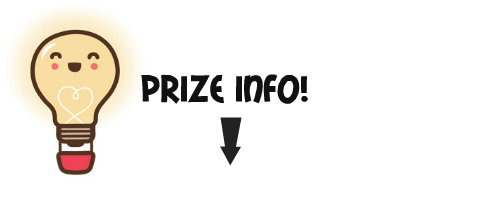
Sink your teeth into this prize pack that features Tammi’s latest release: one personalized copy of NUGGET & FANG, one super shiny poster with a teacher’s guide on the back, and two Nugget tattoos that look fabulous on any bicep (or fin).
And…Tammi’s also offering a picture book critique to another lucky winner!
This prize pack and critique will be given away at the conclusion of PiBoIdMo. You are eligible for these prizes if:
- You have registered for PiBoIdMo.
- You have commented ONCE ONLY on today’s post.
- You have completed the PiBoIdMo challenge. (You will have to sign the PiBoIdMo Pledge at the end of the event.)
Good luck, everyone!
 In past PiBoIdMo posts, I’ve encouraged you to…
In past PiBoIdMo posts, I’ve encouraged you to…
This time around, I want to focus on structure.
Just like houses and dinosaurs, every story needs an underlying framework.


Most of my books follow the Classic Picture Book Structure:
- MC has a problem
- MC faces obstacles that escalate
- MC encounters a black moment in which things can’t possibly get any worse
- MC figures out how to solve the problem
- MC grows/changes by the book’s end
My latest book, PRINCESS IN TRAINING, is an example of this.
Behold!
Princess Viola is great at skateboarding and karate-chopping, but she’s lousy at the royal wave, walk, and waltz. The king and queen are not pleased. What’s a princess to do? Attend the skill-polishing Camp Princess, of course. In the end, it’s a good thing Viola is made of tougher stuff. Who else will save the day when a hungry dragon shows up?
This is how the Classic Picture Book Structure works with PRINCESS IN TRAINING:
- Princess Viola Louise Hassenfeffer has a royal problem. She is not an ordinary princess and the kingdom is unhappy about it.
- Princess Viola faces three obstacles at Camp Princess (she is unable to properly master the royal wave, royal fashions, and royal dancing).
- A hungry dragon shows up at Camp Princess.
- Princess Viola uses her unique skill set to save the day.
- Princess Viola may not be an ordinary princess, but she is deemed the darling of her kingdom anyway.
Although the Classic Picture Book Structure is my super-favorite way to frame a story, there are a variety of other options. Below are many of them along with some examples.
Circular:
The story’s ending leads back to the beginning
If You Give a Mouse a Cookie; When a Dragon Moves In
Concept:
The story focuses on a single topic or category
All the World; Kindergarten Rocks; Hello Baby!
Cumulative:
Each time a new event occurs, the previous events in the story are repeated
My Little Sister Ate One Hare; I Know an Old Lady Who Swallowed a Fly
Mirror:
The second half of a story echoes what occurred in the first half of the story
Old Bear and His Cub; Boy + Bot; A Sick Day for Amos McGee
Parallel:
Two storylines are taking place at the same time
The Dog Who Belonged to No One; Meanwhile Back at the Ranch
Reversal:
Character and/or plot is portrayed in a way that is opposite from the norm
Bedtime for Mommy; Children Make Terrible Pets; Little Hoot
This month, I’m challenging myself to come up with at least one story idea for each of those frameworks. C’mon, groovy PiBoIdMo people. Who’s with me?
Tammi Sauer has five picture books debuting in 2012: Me Want Pet!, illustrated by Bob Shea (Paula Wiseman/S&S); Bawk & Roll, illustrated by Dan Santat (Sterling); Oh, Nuts!, illustrated by Dan Krall (Bloomsbury); Princess in Training, illustrated by Joe Berger (Houghton Mifflin Harcourt); The Twelve Days of Christmas in Oklahoma, illustrated by Victoria Hutto (Sterling). She recently sold two books at auction to Houghton Mifflin Harcourt. The idea for one of those books—The Farm that Mac Built—sprang from her 2011 PiBoIdMo Idea List. It has a cumulative structure. Ooh.


And another “ooh” for you: there’s a PRINCESS IN TRAINING prize pack waiting for a lucky PiBoIdMo’er who completes the 30-ideas-in-30-days challenge. Comment on this post AND complete the challenge to be entered (you’ll be asked to take the “PiBo Pledge” on December 1st to verify you have 30 ideas). A winner will be randomly selected in early December. Good luck!

